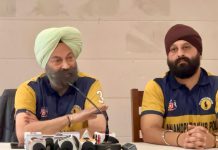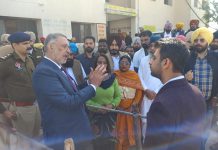
-Environment Minister presides over the maiden meeting of high-powered committee to suggest measures for cleaning of the rivers
CHANDIGARH : “Sewerage of the cities will also not be allowed to be thrown in the rivers without its treatment and strict action will be taken against municipal corporations responsible for throwing polluted water into the rivers.” It was strictly cautioned by the Environment Minister Mr. Om Parkash Soni, who was presiding over the maiden meeting of the high-powered committee, constituted by the Chief Minister to suggest measures for cleaning of the rivers in the state. He said that the major sources of the pollution in the rivers are municipal sewage and industrial effluent. 
The Committee, which has entrusted upon the task to suggest ways to ensure supply of clean potable water, have largely discussed the issue of the sewerage of the cities and other toxic water to save rivers and other natural water resources, during the meeting.
Mr. Soni informed that 19 towns are located in the catchment area of the River Sutlej. In these towns, 33 STPs are required to be installed, out of which 31 STPs have been installed and two STPs are yet to be installed. He said that result of 16 sampling points set up by the Punjab Pollution Control Board between upstream of Nangal to downstream of Hussainiwala shows that the water quality of river Sutlej deteriorated due to discharge of untreated/partial treated sewage and industrial effluent mainly of Ludhiana and Jalandhar cities. He said that the quality of water at upstream of Nangal conforms of Class B; the water can be used for outdoor bathing, at downstream of Kiratpur Sahib the water quality gets impaired at conforms to Class C up to upstream of Budha Nullah; this quality can be used as drinking water source after conventional treatment and disinfection. He said that water quality of downstream of confluence of Budha Nullah with river Sutlej deteriorated to Class E due to discharge of untreated/partially treated sewage and industrial effluents of Ludhiana. The water of this quality can be used for irrigation industrial cooling etc. He said that as the river progress further, East Bein joins it, which brings along with it the sewage and industrial effluent from Nawanshahr, Phagwara and Jalandhar. The water quality at downstream of East Bein remains Class E and by the time the river reaches Harike, the water quality improves to Class D due to its self-purification capacity. The water of this quality i.e. D can be used for propagation of wildlife and fisheries.
He said that 11 towns are located in the catchment area of River Beas, where 11 STPs are required to be installed, out of which 9 STPs have been installed and two STPs are yet to be installed. He said that no industrial effluents are discharged into river Beas. He said that 10 sampling points in the Beas pointed out that the water quality of river Beas at Talwara conforms to Class B, which remains same throughout the stretch of river till it reached Harike that the water of this quality can be used for outdoor bathing.
The Minister said that the water of Ravi River is safe for fish and other aquatic animals. He said that one sewerage treatment plant has been started in Amritsar and another would be ready in one and a half months. After this, the sewerage problem will be eliminated from Amritsar. He said that toxic water from factories located near Dera Bassi, is being stopped to spill out in the Ghaggar.
Mr. Sarabjeet Singh, Principal Secretary Science & Technology, Mr. Kahan Singh Pannu, Chairman, Punjab Pollution Control Board (PPCB), Mr. Vinod Chaudhary, Chief Engineer (Drainage), Mr. Balour Singh, Director, PEDA, Mr. Pawan Garg, Member Secretary, PPCB, Mr. K.P. Goyal, Chief Engineer, Water Supply and Sewerage Board were present during meeting.





